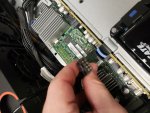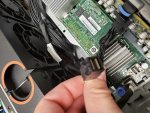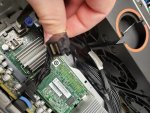Please take into account before reading I am a complete FreeNAS noob. So I have a thinkserver TD350 that has a ThinkServer RAID 720i AnyRAID (LSI 3108) raid controller installed . Let me get the other hardware in here too. The CPU is a single Xeon E5-2640 v4, It has 48gb off ddr3. I don't know what the motherboard model is because its a lenovo designed one. If you're interested more in the system look here https://lenovopress.com/lp0053-thinkserver-td350-e5-2600-v4. There are 4 SSDs and 8 HDDs connected to the raid card right now they are irrelevant as they aren't holding any data but they are configured in JBOD.
We've decided to use FreeNAS 11.3-U2.1 on this server and before you start telling me about FreeNAS not supporting raid cards like this, I know, I've read many forum posts on here regarding this subject, but FreeNAS is what was decided this server would run. I would like to know if anyone has knowledge about getting these types of cards functional properly with SMART in FreeNAS. The main problem I have encountered with this card that's needs to be solved is that I cannot get the smartd service to start. /usr/local/etc/smartd.conf exists but always is empty. /etc/ix.rc.d/ix-smartd doesn't exist (though I'm starting to believe this is just not included in the OS anymore). I should add to this that only the mfi driver allows me to see the drives in FreeNAS and while using the mfi driver if i try to run smartctl for one of the drives I get.
I was hoping that I could get smartctl to give me something if I used the mrsas driver but for the life of me I cant get the drives to show up in /dev/ with mrsas. Will using the mrsas driver help get SMART working or am I screwed because of the raid card. If getting the mrsas driver working will help then I need someone who can explain to me this, on boot with the mrsas driver all of my drives are recognized and assigned device names (da0-da11) and then the boot usb is assigned da12 but at some point in the boot process I get one of these
Here is a the log
If the driver isn't causing this then I have no idea what is causing smartd to not start, nothing I try will get smartd.conf to generate, and I'm running out of ideas. Trying to start it manually returns that it failed to start and that startd.conf is empty. Let me also say I have disabled SMART for my boot usb drive which did not solve the issue and also tried starting the service while just the usb and only one drive (that i know SMART works on) physically in the chassis and the service still refuses to start. My only other thought is that the USB may be causing some issues and we are planning to buy a different boot drive, but I don't know why it would cause all of this. Any help you can give is much appreciated. Thanks.
We've decided to use FreeNAS 11.3-U2.1 on this server and before you start telling me about FreeNAS not supporting raid cards like this, I know, I've read many forum posts on here regarding this subject, but FreeNAS is what was decided this server would run. I would like to know if anyone has knowledge about getting these types of cards functional properly with SMART in FreeNAS. The main problem I have encountered with this card that's needs to be solved is that I cannot get the smartd service to start. /usr/local/etc/smartd.conf exists but always is empty. /etc/ix.rc.d/ix-smartd doesn't exist (though I'm starting to believe this is just not included in the OS anymore). I should add to this that only the mfi driver allows me to see the drives in FreeNAS and while using the mfi driver if i try to run smartctl for one of the drives I get.
Code:
/dev/mfisyspd0: Unable to detect device type Please specify device type with the -d option.
I was hoping that I could get smartctl to give me something if I used the mrsas driver but for the life of me I cant get the drives to show up in /dev/ with mrsas. Will using the mrsas driver help get SMART working or am I screwed because of the raid card. If getting the mrsas driver working will help then I need someone who can explain to me this, on boot with the mrsas driver all of my drives are recognized and assigned device names (da0-da11) and then the boot usb is assigned da12 but at some point in the boot process I get one of these
Code:
(da6:mrsas0:1:35:0): Periph destroyed
Here is a the log
Code:
ugen1.2: <vendor 0x8087 product 0x8002> at usbus1 uhub2 numa-domain 0 on uhub1 uhub2: <vendor 0x8087 product 0x8002, class 9/0, rev 2.00/0.05, addr 2> on usbus1 uhub2: 8 ports with 8 removable, self powered ugen0.3: <Samsung Flash Drive> at usbus0 umass0 numa-domain 0 on uhub0 umass0: <Samsung Flash Drive, class 0/0, rev 3.10/11.00, addr 2> on usbus0 umass0: SCSI over Bulk-Only; quirks = 0x4000 umass0:3:0: Attached to scbus3 ses0 at mrsas0 bus 1 scbus1 target 0 lun 0 ses0: <Lenovo 720ix 0305> Fixed Enclosure Services SPC-3 SCSI device ses0: 150.000MB/s transfers ses0: SES Device da12 at umass-sim0 bus 0 scbus3 target 0 lun 0 da12: <Samsung Flash Drive 1100> Removable Direct Access SPC-4 SCSI device da12: Serial Number 0373519040004367 da0 at mrsas0 bus 1 scbus1 target 29 lun 0 da3 at mrsas0 bus 1 scbus1 target 32 lun 0 da12: 400.000MB/s transfers da12: 61188MB (125313283 512 byte sectors) da0: da3: da12: quirks=0x2<NO_6_BYTE> <ATA Samsung SSD 850 2B6Q> Fixed Direct Access SPC-4 SCSI device da0: Serial Number S2R5NX0H428101L <ATA KINGSTON SUV400S 37R5> Fixed Direct Access SPC-4 SCSI device da3: Serial Number 50026B777302CAED da1 at mrsas0 bus 1 scbus1 target 30 lun 0 da0: 150.000MB/s transfersda3: 150.000MB/s transfersda1: da3: 228936MB (468862128 512 byte sectors) da0: 238475MB (488397168 512 byte sectors) <ATA KINGSTON SUV400S 37R5> Fixed Direct Access SPC-4 SCSI device da1: Serial Number 50026B777302D0B2 da7 at mrsas0 bus 1 scbus1 target 36 lun 0 da0: quirks=0x8<4K> da1: 150.000MB/s transfersda7: da1: 228936MB (468862128 512 byte sectors) <ATA WDC WD10JPVX-00J 1A01> Fixed Direct Access SPC-4 SCSI device da7: Serial Number WD-WX41A46J33P8 da7: 150.000MB/s transfersda5 at mrsas0 bus 1 scbus1 target 34 lun 0 da5: da7: 953869MB (1953525168 512 byte sectors) da2 at mrsas0 bus 1 scbus1 target 31 lun 0 <ATA HGST HTS721010A9 A3U0> Fixed Direct Access SPC-4 SCSI device da2: <ATA KINGSTON SUV400S 37R5> Fixed Direct Access SPC-4 SCSI device da2: Serial Number 50026B777305371A da5: Serial Number JR1004D322U14M da5: 150.000MB/s transfersda2: 150.000MB/s transfers da2: 228936MB (468862128 512 byte sectors) da5: 953869MB (1953525168 512 byte sectors) da9 at mrsas0 bus 1 scbus1 target 38 lun 0 da6 at mrsas0 bus 1 scbus1 target 35 lun 0 da9: <ATA HGST HTS721010A9 A3U0> Fixed Direct Access SPC-4 SCSI device da6: <ATA HGST HTS721010A9 A3U0> Fixed Direct Access SPC-4 SCSI device da6: Serial Number JR1004D31SHP7N da9: Serial Number JR1004D31VXX9M da9: 150.000MB/s transfersda6: 150.000MB/s transfers da6: 953869MB (1953525168 512 byte sectors) da9: 953869MB (1953525168 512 byte sectors) da10 at mrsas0 bus 1 scbus1 target 39 lun 0 da10: <ATA HGST HTS721010A9 A3U0> Fixed Direct Access SPC-4 SCSI device da10: Serial Number JR1004D322U2ZM da10: 150.000MB/s transfers da10: 953869MB (1953525168 512 byte sectors) da0 at mrsas0 bus 1 scbus1 target 29 lun 0 ses0: da1,pass2 in 'ArrayDevice00', SAS Slot: 1 phys at slot 0 da0: ses0: phy 0: SATA device ses0: phy 0: parent 500062b200bfa0bf addr 500062b200bfa088 <ATA Samsung SSD 850 2B6Q> s/n S2R5NX0H428101L detached da7 at mrsas0 bus 1 scbus1 target 36 lun 0 g_access(944): provider da0 has error 6 set da7: <ATA WDC WD10JPVX-00J 1A01> s/n WD-WX41A46J33P8 detached da3 at mrsas0 bus 1 scbus1 target 32 lun 0 g_access(944): provider da0 has error 6 set g_access(944): provider da0 has error 6 set da3: g_access(944): provider da0 has error 6 set g_access(944): provider da0 has error 6 set <ATA KINGSTON SUV400S 37R5> s/n 50026B777302CAED detached da5 at mrsas0 bus 1 scbus1 target 34 lun 0 da5: g_access(944): provider da0 has error 6 set g_access(944): provider da0 has error 6 set <ATA HGST HTS721010A9 A3U0> s/n JR1004D322U14M detached da9 at mrsas0 bus 1 scbus1 target 38 lun 0 (da3:da9: <ATA HGST HTS721010A9 A3U0> s/n JR1004D31VXX9M detached da1 at mrsas0 bus 1 scbus1 target 30 lun 0 ses0: (none) in 'ArrayDevice01', SAS Slot: 1 phys at slot 1 mrsas0:1:32:0): Periph destroyed (da5:da1: ses0: phy 0: SATA device mrsas0:1:<ATA KINGSTON SUV400S 37R5> s/n 50026B777302D0B2 detached da6 at mrsas0 bus 1 scbus1 target 35 lun 0 34:0): ses0: phy 0: parent 500062b200bfa0bf addr 500062b200bfa089 Periph destroyed da6: <ATA HGST HTS721010A9 A3U0> s/n JR1004D31SHP7N detached (da1:mrsas0:1:da10 at mrsas0 bus 1 scbus1 target 39 lun 0 da10: 30:0): <ATA HGST HTS721010A9 A3U0>Periph destroyed (da6:mrsas0:1:35:0): Periph destroyed (da7: s/n JR1004D322U2ZM detached da2 at mrsas0 bus 1 scbus1 target 31 lun 0 da2: mrsas0:1:36:0): Periph destroyed (da9:mrsas0:1:38:0): Periph destroyed (da10:<ATA KINGSTON SUV400S 37R5> s/n 50026B777305371A detached mrsas0:1:39:0): Periph destroyed (da2:ses0: (none) in 'ArrayDevice02', SAS Slot: 1 phys at slot 2 mrsas0:1:ses0: phy 0: SATA device ses0: phy 0: parent 500062b200bfa0bf addr 500062b200bfa08a 31:0): Periph destroyed ses0: da0 in 'ArrayDevice03', SAS Slot: 1 phys at slot 3 ses0: phy 0: SATA device ses0: phy 0: parent 500062b200bfa0bf addr 500062b200bfa08b (da0:mrsas0:1:29:0): Periph destroyed random: unblocking device. Trying to mount root from zfs:freenas-boot/ROOT/default []...
If the driver isn't causing this then I have no idea what is causing smartd to not start, nothing I try will get smartd.conf to generate, and I'm running out of ideas. Trying to start it manually returns that it failed to start and that startd.conf is empty. Let me also say I have disabled SMART for my boot usb drive which did not solve the issue and also tried starting the service while just the usb and only one drive (that i know SMART works on) physically in the chassis and the service still refuses to start. My only other thought is that the USB may be causing some issues and we are planning to buy a different boot drive, but I don't know why it would cause all of this. Any help you can give is much appreciated. Thanks.



